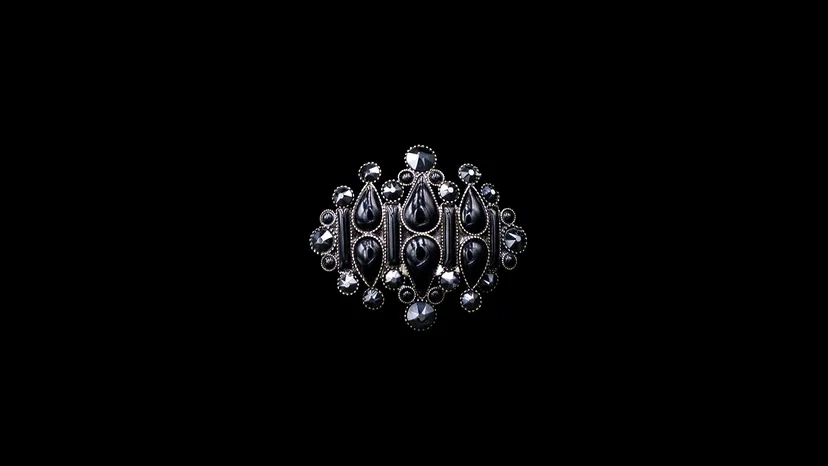 Black precious stones shine in their own intriguing way. Phil Halfmann / Getty Images
Black precious stones shine in their own intriguing way. Phil Halfmann / Getty Images
Some gems dazzle with rainbow brilliance. Others whisper their power in deep, dark silence. Black gemstones aren't flashy, but they hold serious weight in style, symbolism and geology.
Jewelry lovers turn to these stones for their rich color, durability and often surprising origins. Whether you're drawn by their purported grounding energy or timeless aesthetic, black gems bring more than just beauty to the table.
Black diamonds are real diamonds, but their color comes from abundant graphite inclusions or amorphous carbon. They rank 10 on the Mohs hardness scale, making them ideal for daily wear.
Their jet-black look and slightly metallic luster give them a distinctive appearance unlike other diamonds. Black diamonds are also part of the larger family of fancy, colored diamonds.
Black onyx. Maurizio Radice / Getty Images
A variety of chalcedony in the quartz family, black onyx has long been used in mourning jewelry. This semiprecious gemstone often features a solid, dark color and smooth finish. It's less durable than diamonds, rating about 6.5 to 7 on the Mohs scale, but is still suitable for everyday jewelry.
Tahitian black pearl jewelry. Luis Davilla / Getty Images
These pearls form in the black-lipped oyster and offer natural hues from dark gray to green-black. While not truly black, they share a shiny luster and natural beauty prized in high-end jewelry. Their origins in warm Pacific waters add to their allure.
Often mistaken for black sapphire or tourmaline, black spinel is a mineral gemstone prized for its rich, opaque tone and impressive durability. It measures 8 on the Mohs scale and is often used in men's jewelry thanks to its clean, dark look.
Black tourmaline. Zen Rial / Getty Images
Beloved in crystal healing for its purported ability to absorb negative energy, black tourmaline is also a stylish choice for jewelry. Its striated texture and deep black color make it a go-to for bold design.
Black opal. Nugroho Ridho / Getty Images
Found mostly in Australia, black opal is the rarest type of opal. Unlike black crystal opal, which may be semitranslucent, true black opals have a dark body tone with vibrant play-of-color. Their composition includes hydrated silica with trace elements of carbon and iron oxide, which give them a dark body tone.
These sapphires often come from Australia and are known for their dark blue undertones and high durability. They are excellent for daily wear and have a uniform, inky color. Some versions show a star effect, known as black star sapphire, due to rutile inclusions.
Formed from fossilized wood under extreme pressure, jet is a lightweight, black gemstone often used in antique and mourning jewelry. It's softer (about 2.5 on the Mohs scale) but easy to carve and polish.
This diamond substitute has a metallic luster and is made from silicon carbide. It was originally discovered in meteorites, though most is now lab-created. Natural moissanite is extremely rare, but black moissanite offers a durable, affordable alternative for everyday jewelry.
Obsidian. Jasius / Getty Images
A volcanic rock formed from rapidly cooled lava, obsidian is technically a natural glass. Its smooth, reflective surface and sharp edges made it useful in ancient tools and modern adornment.
Obsidian can also occur as snowflake obsidian, displaying white crystalline patches on a black glass base, or remain a pure black volcanic glass, depending on the impurities present.
Less common than red garnet, black garnet can appear almost opaque. Its dark hues make it suitable for those who want black gemstones with a little more subtlety. Its a tough stone, ranking around 6.5 to 7 to 7.5 in hardness on the Mohs scale.
A relative of onyx and agate, black chalcedony offers a smooth, even texture with a deep black finish. Its popular in jewelry making for its polish and durability.
Part of the quartz family, this dark stone gets its hue from inclusions or graphite. It offers strength (Mohs 7) and versatility, often used in bold, geometric designs. It's a staple among jewelry enthusiasts.
Known for its cat's eye variety, black diopside is a semiprecious gem with good brilliance and a slightly greenish-black tint. Its less common but growing in popularity for special occasions and jewelry making.
This stone is technically a variety of either jadeite or nephrite, depending on composition. Its color can range from dark gray to near-black, offering a timeless style for everyday wear or men's jewelry.
We created this article in conjunction with AI technology, then made sure it was fact-checked and edited by a HowStuffWorks editor.


